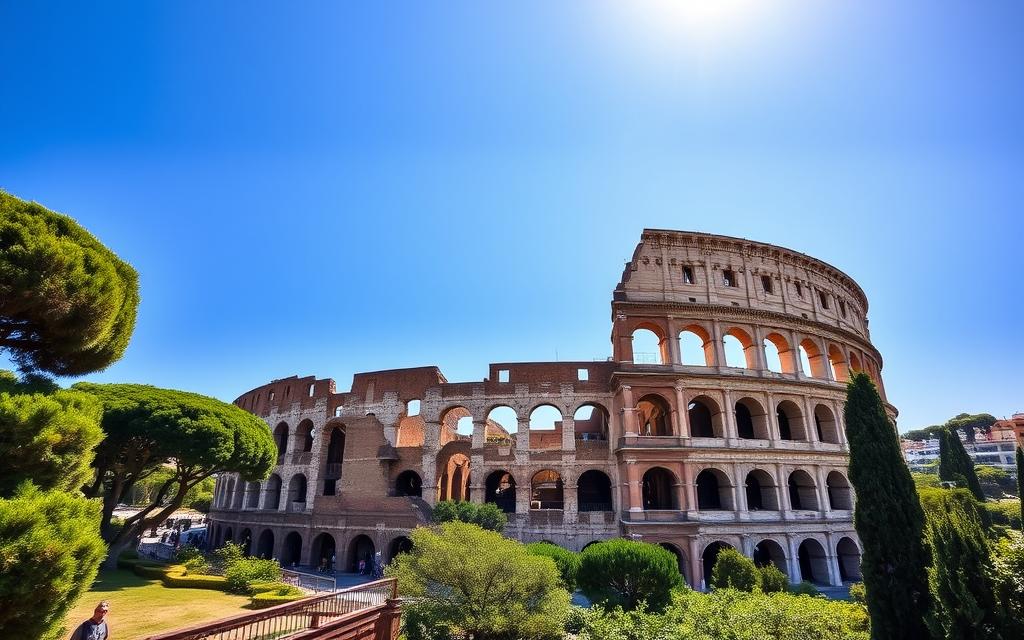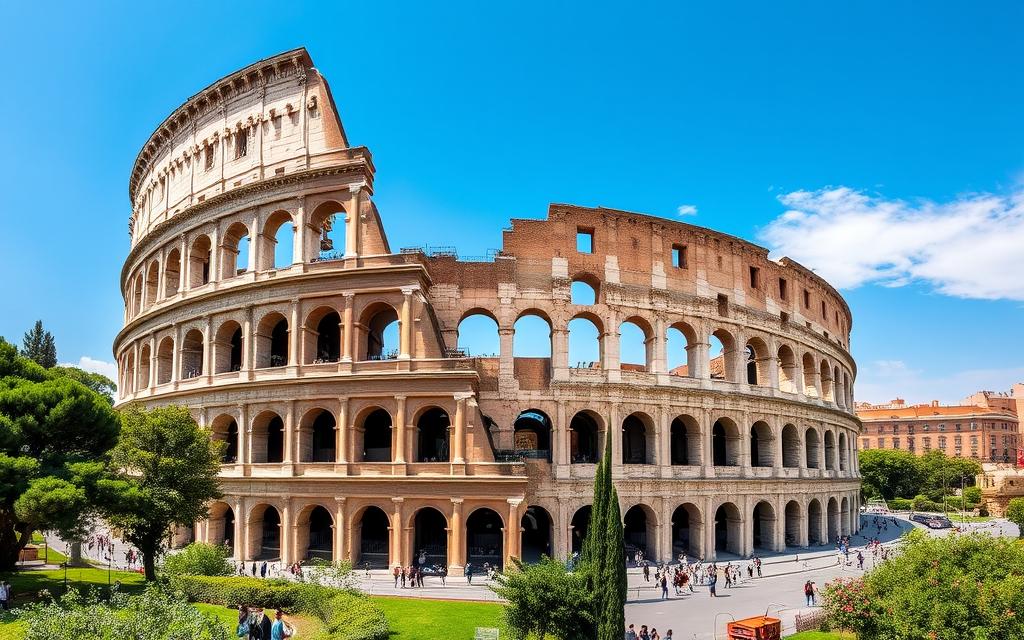Visiting Rome can feel overwhelming because of its rich history. Yet, Rome’s charm comes from its architectural wonders. The Colosseum is a key example, showing Rome’s greatness. Here, you can walk where ancient Romans once did.
It’s a chance to feel the past before entering today’s world. But what secrets does this landmark hold? How can you uncover its mysteries? Get ready for an amazing journey through the Colosseum, a top attraction in Italy.
Ever thought about how the Colosseum was built so quickly? We’ll explore the Roman Architecture and engineering that made it. You’ll learn about the stories that have amazed visitors for ages.
The Grandeur of the Flavian Amphitheater
The Colosseum, a symbol of ancient Roman architecture, is at Rome’s heart. It’s an oval-shaped amphitheater. This massive structure, also called the Flavian Amphitheater, is the largest ever built. It shows the amazing engineering skills of the ancient Romans.
Well-preserved, the Colosseum is one of the ancient world’s greatest wonders.
What is the Colosseum?
The Colosseum was built with travertine limestone, tuff (volcanic rock), and concrete. It could hold 50,000 to 80,000 people. This shows the Roman Empire‘s power and dreams.
Titus dedicated it in 80 CE with 100 days of games. This showed its huge size and beauty.
The Architectural Marvel of Ancient Rome
The Colosseum is 12 stories high, with 80 entrances. It’s a sign of ancient Roman engineering. Its oval shape and materials like travertine limestone and tuff made it strong and beautiful.
“The Colosseum, an emblem of ancient Roman grandeur, stands as a testament to the enduring legacy of the Roman Empire.”
The Colosseum has lasted through time. It still draws visitors worldwide. It shows the ancient Romans’ architectural and engineering skills.
Uncovering the History of the Colosseum
The Legacy of the Flavian Dynasty
The Colosseum is a huge sign of the Flavian Dynasty’s power. It shows the work of emperors Vespasian, Titus, and Domitian. Started by Vespasian in AD 72, it was finished by Titus in AD 80 after Vespasian died. Domitian, Titus’s brother, made it even better.
Transformations Through the Ages
The Colosseum has seen a lot, like a big fire in AD 217. It was also changed a lot in the Medieval era. It was used as a chapel, cemetery, and even a castle. Yet, it still shows the old Roman history and what life was like back then.
Today, the Colosseum in Rome gets over 5 million visitors every year. It’s a big hit with tourists. It had 80 entrances to handle the crowds, showing how smart the ancient Romans were.
| Statistic | Value |
|---|---|
| Annual Visitors to the Colosseum | Over 5 million |
| Number of Entrances | 80 |
| Height of the Colosseum | 48 meters |
| Total Area | 6 acres (24,000 m²) |
| Number of Trap Doors in the Arena | 36 |
| Construction Labor | Approximately 60,000 Jewish slaves |
| Construction Duration | Less than a decade |
The Colosseum is huge, standing 48 meters tall and covering 6 acres. It’s the biggest amphitheater ever built. It had 36 trap doors to make shows more exciting, showing the Romans’ love for public spectacles.

It was built in just over 9 years with the help of about 60,000 Jewish slaves. This shows how much power and resources the Roman Empire had for big projects. It also survived big earthquakes in 847 AD and 1231 AD, proving its strong design and importance in history.
“The Colosseum was constructed by the Flavian dynasty as a gift to the Roman people, symbolizing power, benevolence, and unity through shared cultural experiences.”
Top Tourist Attractions Colosseum, Italy
The Colosseum in Rome, Italy, is a top spot for travelers. It’s the largest amphitheater built by the Roman Empire. It shows off ancient Roman engineering and is a marvel.
Rome has many historical sites. They help visitors understand the city’s rich culture. The Colosseum is near the Roman Forum and Piazza Venezia. This makes it easy to start exploring Rome’s ancient wonders.
The Arch of Constantine is close by. It’s a symbol of Rome’s past. Historians say there were once 36 such arches in the city.
The Mamertine Prison gives a glimpse into Roman justice. The Roman Circus was used for chariot races. The Palatine Hill and Roman Forum show what life was like in ancient Rome.
The Colosseum is a great place to start exploring Rome’s history. You can see the Flavian Amphitheater and learn about the city’s past. It’s a deep dive into Rome’s ancient world.
Intriguing Facts About the Colosseum
The Colosseum in Rome is a wonder of ancient engineering. It’s not just big and grand. It also has many interesting facts that show its rich history and design.
80 Entrances for Efficient Access
The Colosseum has an amazing 80 entrances. This design helped huge crowds move in and out easily. It was made for the events and shows inside.
World’s Largest Amphitheater
The Colosseum is the biggest amphitheater ever built. It covers 6 acres and is 48 meters tall. Its size shows the ancient Romans’ engineering skills and big dreams.
It also had 36 trap doors for exciting entrances and effects. The Colosseum was built fast, in just 10 years. This shows the skill of its builders.
The Colosseum has stood strong through many earthquakes. It was a gift from the Flavian dynasty to the Roman people. It shows their power and kindness.

“The Colosseum is not just a monument, but a testament to the ingenuity and ambition of the ancient Roman civilization.”
Planning Your Visit to the Colosseum
The Colosseum in Rome, Italy, is a top spot for travelers. It’s right in the heart of Rome, making it easy to get to. You can use public transport to make your visit smooth.
Location and Transportation
The Colosseum is in a great spot. The Colosseo Metro station is just a minute away. You can also take the bus, tram, or taxi to get there. It’s easy to reach this ancient wonder.
Nearby Attractions
There’s more to see around the Colosseum. You’ll find the Arch of Constantine, Mamertine Prison, and the Roman Circus nearby. The Palatine Hill and Roman Forum are also close. These places let you dive deep into Rome’s ancient history and culture.
| Attraction | Distance from Colosseum |
|---|---|
| Roman Forum | 5 minutes’ walk |
| Palatine Hill | 10 minutes’ walk |
| Arch of Constantine | 2 minutes’ walk |
| Mamertine Prison | 7 minutes’ walk |
| Roman Circus (Circus Maximus) | 15 minutes’ walk |
Practical Tips for Your Colosseum Experience
Security Measures and Accessibility
When you visit the famous Colosseum in Rome, Italy, you’ll need to follow some security rules. You can’t bring big bags, suitcases, or backpacks inside. But, small and medium bags are okay. They will go through a metal detector for safety.
The Colosseum welcomes visitors with disabilities. The main entrance has no stairs and an elevator. Inside, most areas are flat, making it easy to explore.
Beat the Crowds and Optimize Your Time
To skip the long lines, book your Colosseum tickets in advance. Or, join a guided tour for quick access. The best times to visit are early morning or just before it closes. This way, you’ll miss the summer rush.
Wear comfy shoes and clothes that breathe. This will help you enjoy the vast site and its ancient beauty.
Knowing the Colosseum’s rules, accessibility, and best times to visit makes your trip better. You’ll have a memorable time at this ancient wonder.
“The Colosseum is a marvel of ancient Roman engineering and stands as a testament to the ingenuity and ambition of the Flavian dynasty.”
Unveiling the Wonders of Ancient Rome
Walking through Rome is like starting a thrilling journey through Ancient Rome’s history. The Colosseum, a symbol of the Flavian Dynasty’s skill, is at the center. It’s the biggest amphitheater ever, showing the city’s deep history and culture.
The Roman Forum and the Pantheon are also key sights. They show the lively social, political, and religious life of ancient Rome. These sites amaze and inspire, taking visitors back in time.
For a deep dive into Rome’s past, City Rome Tours offers great tours. They’ve won the Tripadvisor Travelers’ Choice Award: Top 10 Experiences – Italy. These tours give a full view of the city’s history and stunning buildings.
| Tour Details | Highlights |
|---|---|
|
|
Rome is a must-see for history buffs and anyone curious about the past. The Colosseum, Pantheon, and Roman Forum will amaze you. They show the city’s grand history and culture.
“Visiting the Colosseum and the Roman Forum was the highlight of our trip to Rome. The guided tour provided us with a deep understanding of the city’s rich history and architectural marvels.”
Immerse Yourself in the Echoes of History
Visiting the Colosseum in Rome is more than a tourist spot. It’s a trip back in time, where ancient Roman life echoes through the ages. Exploring this marvel lets travelers dive into Rome’s rich past and cultural heritage.
The Colosseum shows off Rome’s architectural skills and love for grand shows. It’s a top spot in Italy, drawing many visitors. Guided tours offer quick entry and special access to hidden spots.
Guides share the Colosseum’s secrets and history. They connect visitors to ancient Rome’s heart. From the Roman Forum to the Arch of Titus, Rome’s past comes alive.
Source Links
- https://www.rome.net/colosseum
- https://www.thecolosseum.org/visit/
- https://theromanguy.com/italy-travel-blog/rome/colosseum/top-things-to-see-at-the-colosseum/
- https://www.britannica.com/topic/Colosseum
- https://www.touristitaly.com/colosseum-in-rome-visitors-guide/
- https://www.romaexperience.com/post/the-colosseum-rome
- https://roaminghistorian.com/2015/10/18/colosseum-rome/
- https://www.througheternity.com/en/blog/rome-travel-guide/top-things-to-do-near-colosseum-rome.html
- https://www.vietravel.com/en/around-the-world/12-toprated-tourist-attractions-in-italy-v11996.aspx
- https://www.thecolosseum.org/facts/
- https://theromanguy.com/italy-travel-blog/rome/colosseum/astounding-facts-about-the-colosseum/
- https://www.natgeokids.com/uk/discover/history/romans/colosseum/
- https://theromanguy.com/italy-travel-blog/rome/colosseum/visiting-the-colosseum-everything-you-need-to-know/
- https://ourlittlelifestyle.com/2024/09/choosing-the-best-colosseum-tour-in-rome-italy/
- https://walksineurope.com/2023/12/05/5-quick-tips-for-enjoying-the-colosseum-in-rome/
- https://darkrome.com/blog/Rome/essential-guide-before-colosseum-tour
- https://www.findingtheuniverse.com/colosseum-rome-guide/
- https://www.cityrometours.com/en/blog/travel-in-rome/unveiling-wonders-ancient-rome.html
- https://citywonders.com/rome-tours/colosseum-tours
- https://www.romaexperience.com/traveler-toolkit/colosseumtours
- https://www.througheternity.com/en/colosseum-tours/
- https://www.peek.com/rome-lazio-italy/r0npzy/exploring-romes-timeless-echoes-a-journey-through-the-colosseum-and-forum/ar0zwmn4

